Look below: a tourist t-shirt from Monterey, California, across the Monterey Bay from my home in Santa Cruz. I can wave at Monterey from the Santa Cruz shore.
Both cities are part of California’s underdeveloped (thank goodness) Central Coast, which stretches from south of the San Francisco Bay area down to just north of Greater Los Angeles.
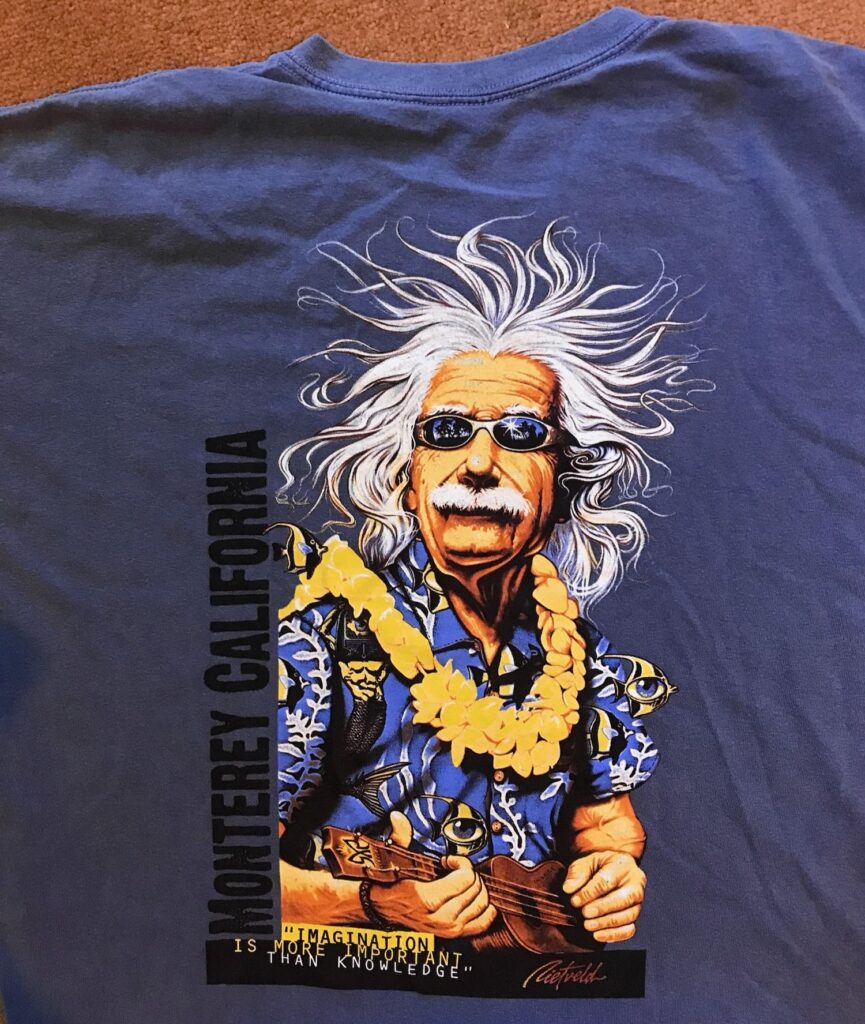
Monterey does a good tourist business: it possesses good weather, natural beauty, tourist traps, a classy aquarium, boating, fishing, kayaking. What’s not to like? No doubt “Monterey” souvenir tees sell hotly.
Especially this one, with a rather nice graphic called “Al’s Vacation” by California surf artist/surrealist Rick Rietveld. Many of Rietveld’s illustrations appear on t-shirts.
Now as an artifact, this t-shirt is unexceptional: nothing more than a random graphic chosen by a souvenir vendor to be printed on cotton along with the town’s name.
Or is it more?
I’m recently retired — yay. And with time on my hands, I’m growing a tendency to focus on something ordinary and dive right down the rabbit hole with it. It’s called “going meta,” short for “going metaphysical.” (Pardon me while I straighten my tin-foil hat.)
When you go meta on some matter, you don’t just look for reasons. You look for reasons for the reasons:
Why a picture of Einstein? Does Einstein have something to do with Monterey? I’ve never heard of such a thing, but does the souvenir shop know something that I don’t? Or is this tee about nothing more than the California beach vibe and Albert Einstein, who after all is a 20th century icon for The Beyond?
I mean, if someone can put the image of Jesus blessing a motorcycle on a t-shirt (they do), why not Einstein on the beach with cyclopean angel fish swimming off his shirt?
Now, know this about tourist areas like Santa Cruz and Monterey: they’re all about creating as many selfie-centric attractions as possible. If, say, John F. Kennedy had wandered through here and thrown up on the sidewalk after a night’s bender, you’d by now find that piece of pavement surrounded with a bronze ring bearing a nice plaque (“On this spot in 1959…”) for all the tourists to pose next to, iPhone raised high.
I exaggerate: not very much, though. Not at all.
Again, Einstein is a giant of the 20th Century; almost, its prophet. My “going meta” obsession insisted that I find out if he’d ever made it up this way. Because he had definitely made it to California. In the ‘30s, he almost commuted to California. There would be a sign, a plaque, a marker. Something.
So let me begin at the end. There could very well be a reason for this shirt. There’s a story in circulation down Monterey/Carmel way supporting the idea that Einstein came by to visit something.
But it doesn’t fit the facts. And I’ve talked to people who know facts.
The story does have elements of truth. But the real story, the story behind the story, the meta story, is about two photographers. One, Johan Hagemeyer, you’ve never heard of; and another, Edward Weston, who you just might have. Let’s go.
This was in the early days of the COVID lockdown. I was stuck in my house with no reference material except the Internet. But I did have access to that great society of municipal scholars, the reference librarians of the state of California. They answer their email. They are heroes.
The reference desk at the Monterey Public Library got back to me quickly. They told me that a hotel called the Forest Lodge in Carmel had an “Einstein Cottage.” Monterey and Carmel are next door to one another, and pretty much joined at the hip.
I looked up the Forest Lodge. The cottage exists. And while there’s nothing overtly Einsteinian about the structure itself, one wall of the Forest Lodge’s main building features a mural of Einstein holding a sign. The sign reads “Love is the Answer.”
An artist who calls himself Mr. Brainwash painted that mural; he’s an acolyte and imitator of the famous street artist Banksy. Mr. Brainwash hit town in 2010 for the Carmel art and cinema festival and offered a free mural to anyone who’d give him a blank wall. Apparently the Forest Lodge offered their wall, and Einstein.
So I’d found an Einstein’s marker! He’d been there, or at least the hotel seemed to think so. I sent the hotel an email for verification and details. I also emailed the Carmel Public Library. The history room librarian answered promptly: the library was short-staffed, but she’d do what she could when she could.
But what would get Einstein to Carmel? I could find no evidence he’d ever been. But it’s well recorded that he got moderately close.
From 1931 through 1933, Einstein taught winter quarters at the Cal Tech campus in Pasadena. It sure beat Berlin in January. Einstein and his wife enjoyed California immensely; to them, it was paradise.
And while he sojourned in California, Einstein got around. His travels through the southland are well documented online. He even made it to the Central Coast: to the home of a Caltech trustee in Santa Barbara in February 1931, and perhaps at other times as well.
From the February ’31 visit, there exists a rather forlorn picture of a warmly-dressed Einstein standing under grim cloud cover on a Santa Barbara beach. That’s the Central Coast for you sometimes. This pic is certainly not tourist tee fodder.
Einstein’s host in Santa Barbara also took the famous picture of Einstein riding a bicycle around the grounds of his home (on that day or another day). That inspired me to ransack my t-shirt collection for yet another t-shirt tying Einstein to Monterey: one issued for the Monterey County “Bike Week 2010.” It showed an edited version of that very same image (they added a helmet). Hmmm, another t-shirt linking Einstein to Monterey.
Santa Barbara’s only a couple of hundred miles short of Monterey/Carmel area: tantalizing. But was there any firmer connection between Einstein and Monterey (or Carmel)? I searched the Internet for any link.
One exists. Just one.
That “link” is a photographer who took pictures of Einstein in January 1931, the month before Einstein hit the gloomy beach in Santa Barbara.
His name was Johan Hagemeyer, a well-respected photographer of portraits and landscapes, for your hire or for his own artistic satisfaction. In the 1920s, his studio in San Francisco pulled in society customers, while his summer studio in Carmel pulled in tourists. He was originally from the Netherlands.
Carmel was an old-school Bohemian art colony in those days, maybe some years from hitting the big time — and becoming less truly bohemian. But it was still a very hip place to be. The natural beauty of the place — unique in its way — drew artists like bees to flowers. Hagemeyer was something of a notable in the colony, as he actually had money and owned one of the few galleries where art could be displayed.
In January 1931, Hagemeyer had a portrait session with Einstein in Los Angeles. Hagemeyer took some rather sporty portraits of the great man. I rather like this photo of “kick-back” Einstein: all that Einstein needs is a bottle of Pabst.
As a successful portrait photographer, Hagemeyer was extremely good at engaging his clients in the process. Einstein even wrote him a thank-you note — in German.
I wondered if Einstein might have continued north to see Hagemeyer in Carmel after stopping in Santa Barbara in February, but no. Hagemeyer was living in Los Angeles at the time, trying to pick up fat commissions from all the new money down south. In ’31, a friend of Hagemeyer’s was renting Hagemeyer’s empty Carmel studio.
So, I thought: if Einstein never came to Carmel (or Monterey), then t-shirt means nothing.
Of course the next day, someone emailed me to say that Einstein did come. The Forest Lodge concierge wrote:
Einstein did stay at the Forest Lodge long before it became a hotel. I’m not sure of all the details, but Edward Weston, famed photographer here, Owned or lived on that property and often had gatherings of guests including Einstein and Salvadore Dali, Must have been incredible here then during the Bohemian days. I don’t know of any documentation, ie: photos etc, but since Weston was a photographer and his family still owns a gallery here, that might be a place to start.
This is the story that could have launched the t-shirt. But notice that it’s just hearsay. Edward Weston was another Carmel photographer, and eventually a much more famous one than Hagemeyer. Weston was the friend to whom Hagemeyer rented his Carmel studio while Hagemeyer was in Los Angeles. Weston lived there for a year or two, and never again.
Hagemeyer was an old-school photographer, a pictorialist. Pictorialists thought that pictures should look like paintings: lines were not sharp, but painterly and subtle. Pictorialists would alter the photo after the fact to get what they wanted.
Weston, on the other hand, believed in absolute clarity of line and no post-camera alterations; he and his crowd — Ansel Adams, Imogene Cunningham, others — went on to found modern artistic photography: clear, sharp images of natural forms. The striking landscapes of the Carmel area, particularly Point Lobos, drew such photographers.
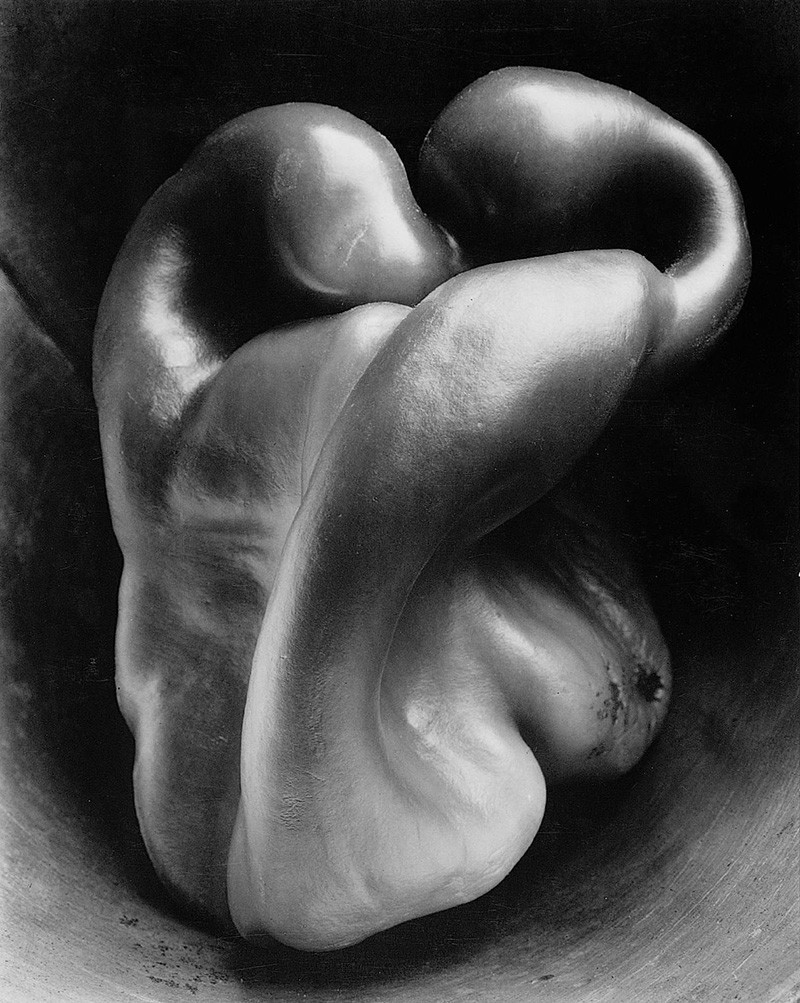
Weston photographed only natural forms: rocky landscapes, sea shells bell peppers, nudes, nudes and rocky landscapes, and so on. If he took your portrait — and he did a bit of that — you’d see sharp, clear lines. Whether you liked it or not.
Hagemeyer and Weston respected each other, but went their separate ways after Hagemeyer returned from LA; there was an argument about rent.
Weston left town for awhile, won a Guggenheim fellowship, became famous, came back to town and built his own house aways out from things. He lived there from the late ‘30s into the ‘50s.
I went back to the reference librarians for clarity. They had none personally, but told me how to find Weston’s grandchildren. Weston’s descendents still lived around Carmel. One ran a gallery dealing in modern art photography like Weston’s, as the Forest Lounge concierge had written. The other had a photography business and lived in Weston’s old house.
I emailed them; they answered. The answers were the same: Einstein here? We never heard; we would have heard. We would have been told.
Weston had always kept a guest book. One of the family searched through it for me; Einstein’s name was conspicuously absent.
At roughly that point the Carmel history librarian got back to me as promised; she’d ransacked the newspaper archives, copies of Weston’s daybooks (personal journals) and all other sources of local happenings and found not one reference to Einstein visit. A visit by such a luminary as Einstein could have been kept secret, she said, not in a publicity-hungry art colony like Carmel. Someone would have known, she said. Someone would have said. And no one said.
One of the grandchildren — his wife, actually — told me what I really needed to know: the Einstein Cottage at the Forest Lodge is Hagemeyer’s old studio. And then I understood how the hotel’s undocumented story could have become garbled.
Seventy five years is a long time. Think of a game of telephone that’s 75 years long. Einstein, Hagemeyer, Weston: in a way they’re all connected to the cottage, though Einstein never visited. Two of those names are photographers. Two of those names are famous. And over time and retelling, Hagemeyer — the least famous of the three — drops out of the account. Weston becomes the long-time resident of the cottage, and Einstein becomes associated with him rather than Hagemeyer.
Weston’s still a household name in Carmel while Hagemeyer is nearly forgotten. And they had both lived in Hagemeyer’s studio. By that logic, Einstein would have had to come to Carmel for reasons other than photography; perhaps just to meet Weston and other notables. Weston didn’t photograph Einstein. You’ll find no images anywhere.
The concierge’s story has Dali also visiting the Carmel studio, and he might have: in later years, as Hagemeyer’s guest. Hagemeyer moved back into his studio from Weston in ’31 or not long after. He lived in Carmel full-time through the ’40s. It was only in the ’40s that Dali came to Carmel for a few years, fleeing the madness of Europe. I’d bet money that Hagemeyer invited Dali over to the studio for drinkies and talk at least once. Hagemeyer was still a well-known figure in Carmel and could well have held socials regularly.
And of course Dali could also have visited Weston up at his own house. The great surrealist had plenty of time to make the rounds.
Hagemeyer left Carmel in ’47; he felt that the art colony had become too commercial. He should see it now. Hagemeyer moved back to the Bay Area, an eccentric old age, obscurity, and poverty. Weston died a few years before him after a long illness that kept him from working; at time of death he had $300 in the bank. The wages of art are often not paid in money.
To sum up: I’m convinced that Einstein never came to Carmel. The only reference otherwise is as verbal account that’s not in any record. As the Carmel history librarian said: if he’d come to Carmel, the word would have gotten out and been recorded. And not to just a few people in the hospitality business (who didn’t write it down.)
So my research into the Monterey-branded Einstein t-shirt is….
…at least a partial success.
It doesn’t matter that Einstein never visited Monterey/Carmel. It doesn’t matter whether I’m right or wrong. What matters is that some people tell a story that he did. And that story could easily have been the motivation for stocking a souvenir stand with Einstein t-shirts.
Imagine this conversation at a souvenir shop on Cannery Row:
Tourist: Hey, awesome t-shirt of Einstein. Did he live here or something?
Clerk: They say he visited in the ‘30s to visit with Edward Weston, the famous photographer.
Tourist: Kewl. Got it in XL?
Is the story really true? Well… it’s truly a story. Some people tell it. They may even believe it. It’s true enough to sell a t-shirt, or rent a cottage.
Beyond that, you may also ask: did Einstein ever really cavort free of care at the ocean’s edge, aside from that grim winter day in Santa Barbara?
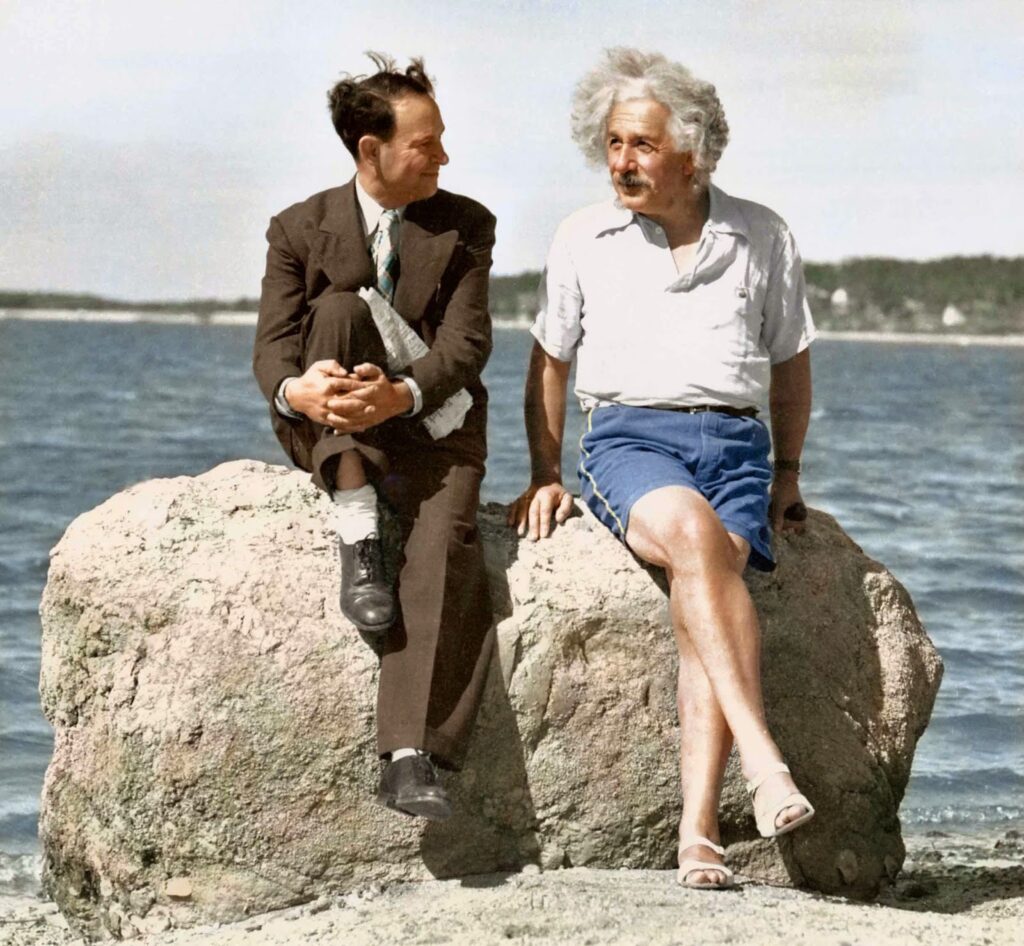
Oh yeah. Nice legs on that physicist.

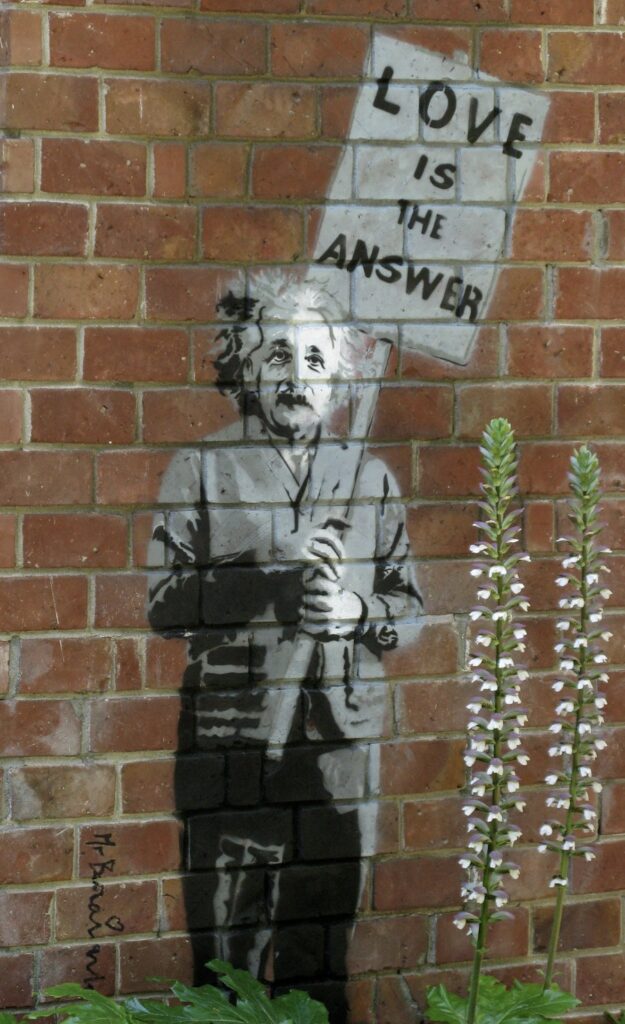
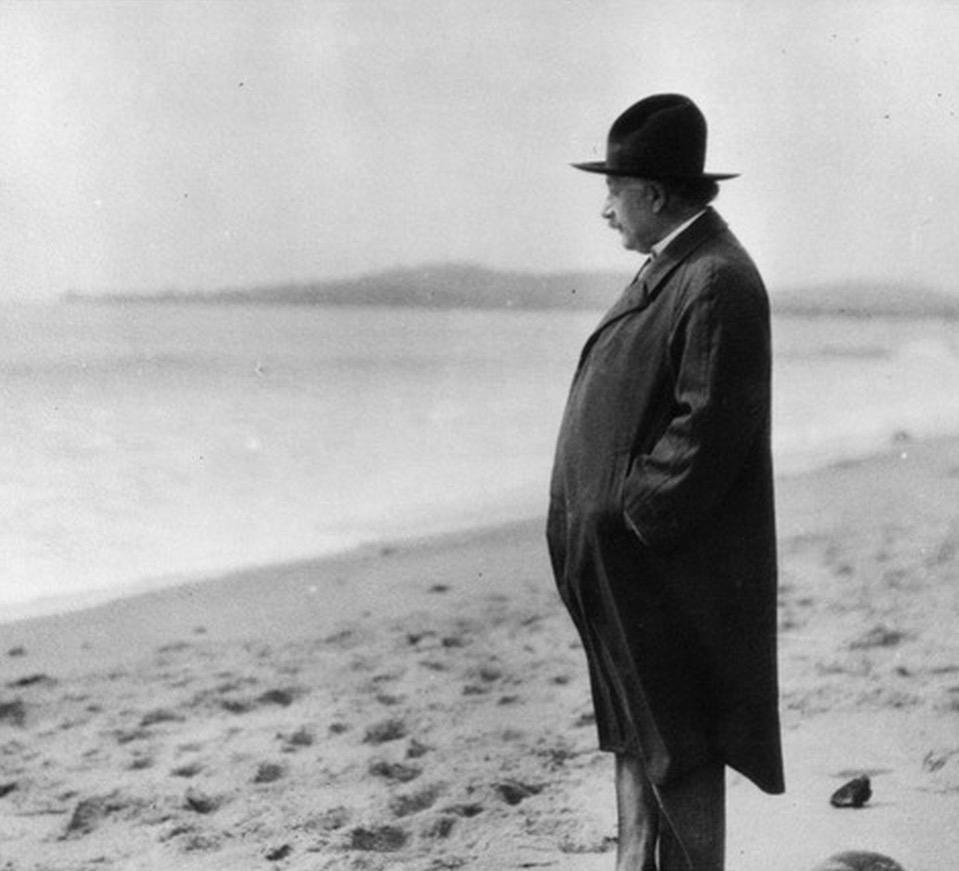
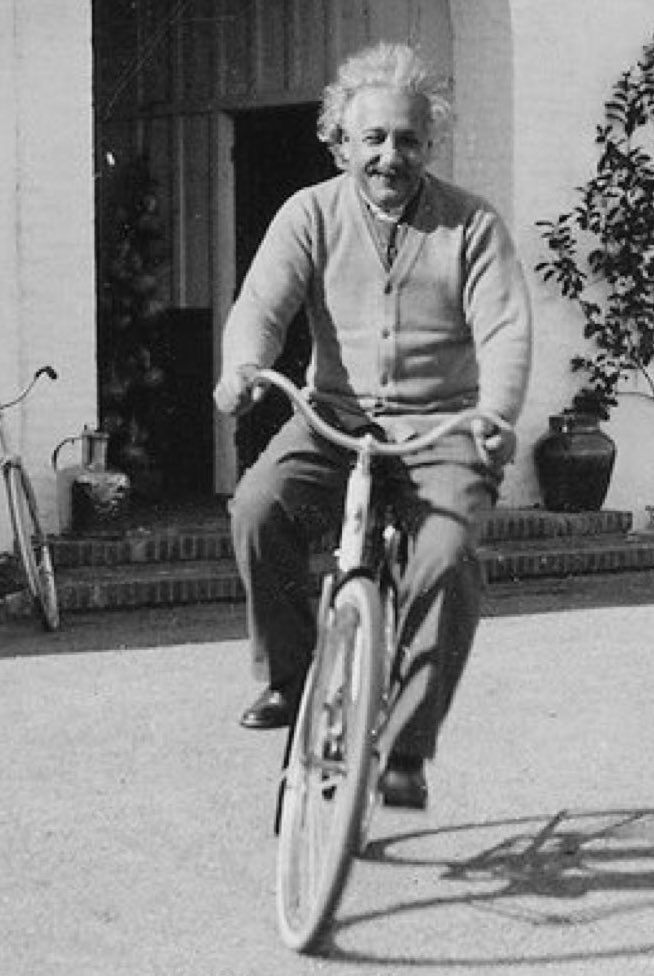
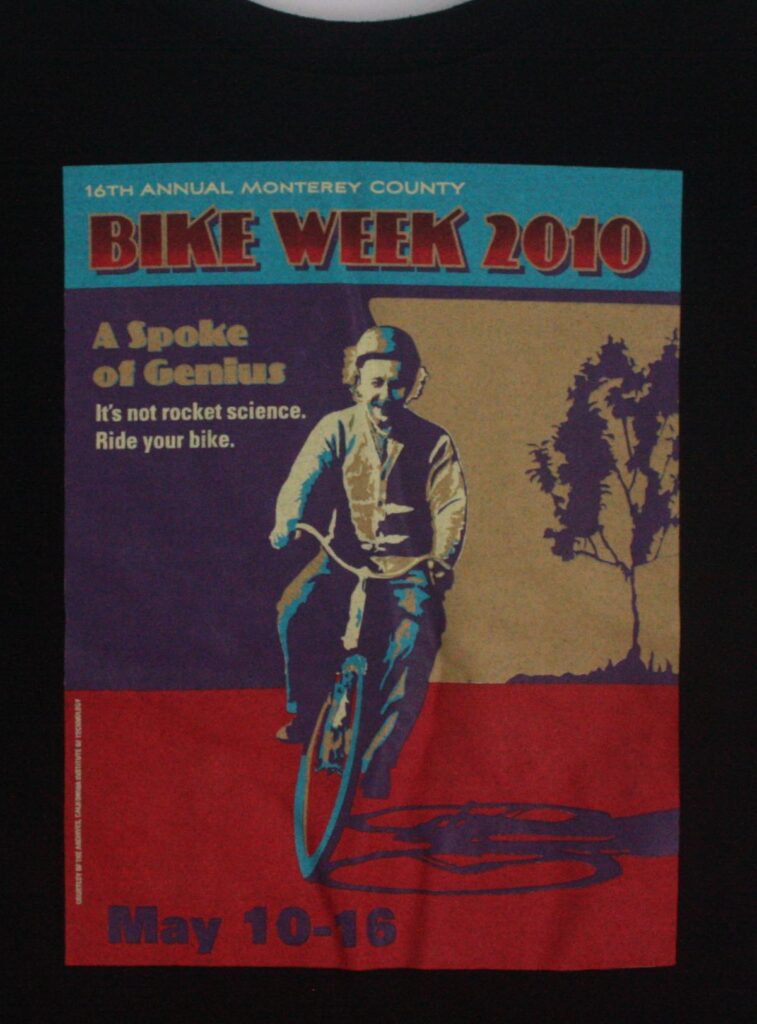
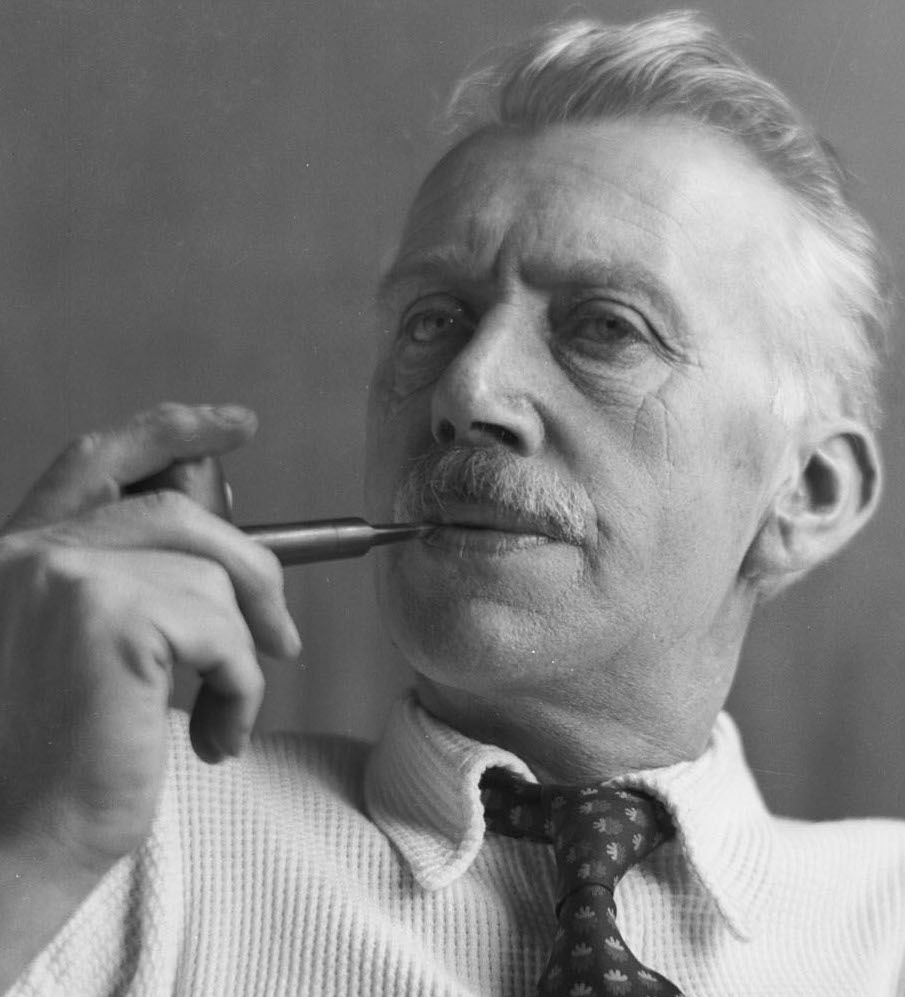
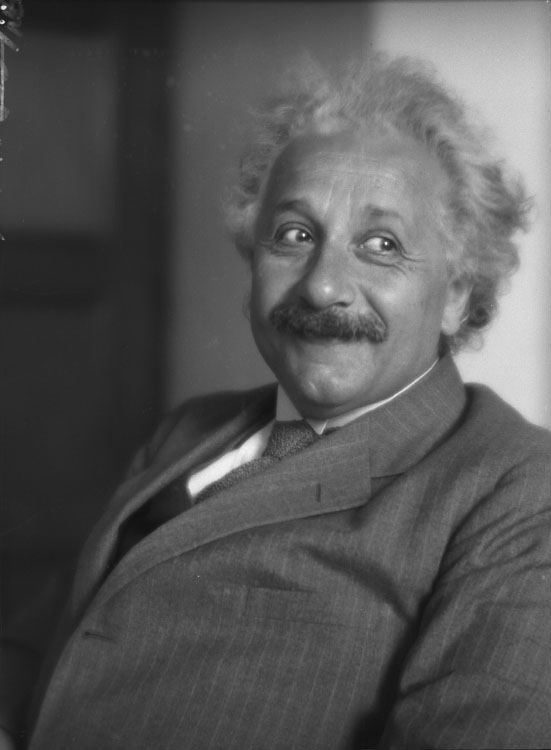
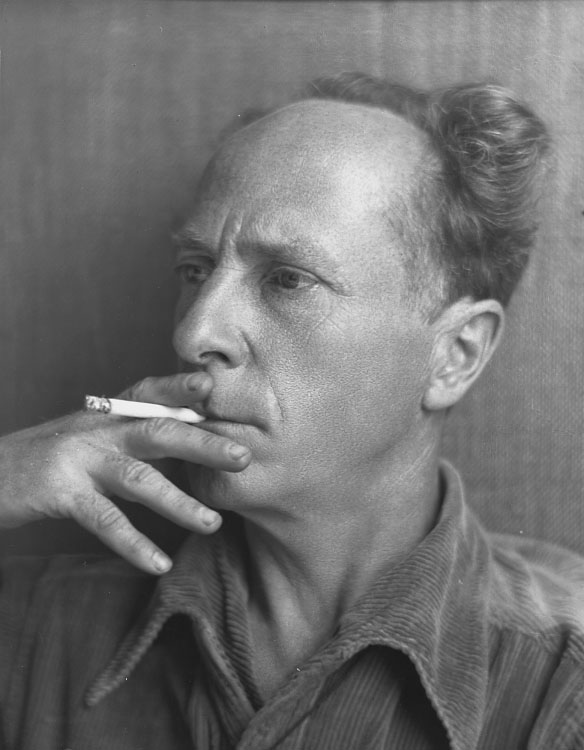
Haha, thanks for the deep dive. My husband got this shirt in 2014 when visiting Monterey and wanted to get another one this year, 2024. We were wondering if there was any significance to it or if it was just a cool design.
Looks like now we know
Yes, I’m about 98 percent sure of my explanation. Maybe Einstein was never there, but we absolutely know that some people thought he had been. I just tried to fill in the “why.”